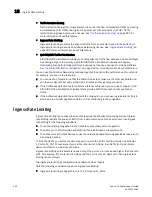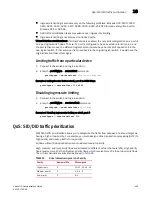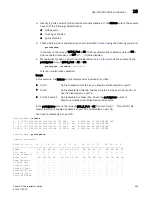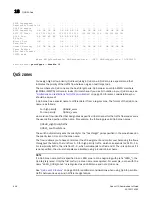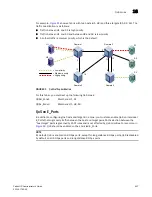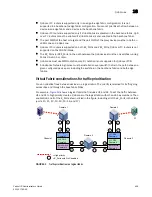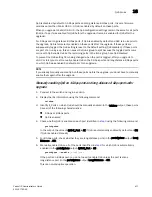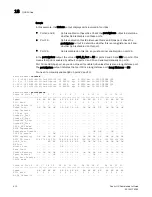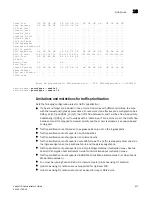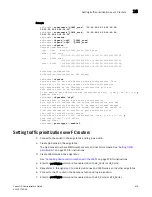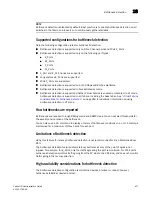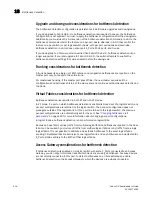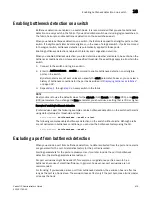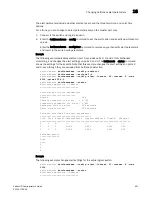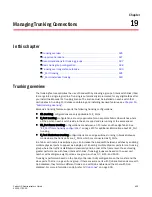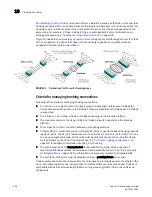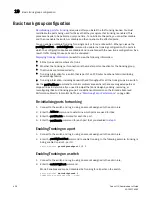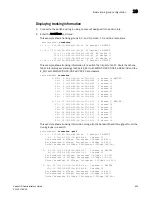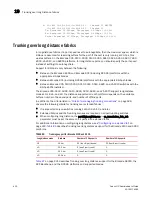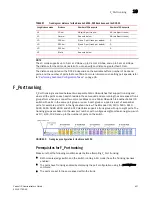
416
Fabric OS Administrator’s Guide
53-1001763-02
Disabling QoS
18
Disabling QoS
1. Connect to the switch and log in as admin.
2. Enter the cfgRemove command to remove the QoS zones from the current zone configuration.
3. Enter the portCfgQos command to disable QoS on the E_Ports.
Bottleneck detection
Bottleneck detection does not require a license.
A
bottleneck
is a port in the fabric where frames cannot get through as fast as they should. In other
words, a bottleneck is a port where the offered load is greater than the achieved egress
throughput. Bottlenecks can cause undesirable degradation in throughput on various links. When a
bottleneck occurs at one place, other points in the fabric can experience bottlenecks as the traffic
backs up.
The bottleneck detection feature detects two types of bottlenecks:
•
Latency bottleneck
•
Congestion bottleneck
A
latency
bottleneck
is a port where the offered load exceeds the rate at which the other end of the
link can continuously accept traffic, but does not exceed the physical capacity of the link. This
condition can be caused by a device attached to the fabric that is slow to process received frames
and send back credit returns. A latency bottleneck due to such a device can spread through the
fabric and can slow down unrelated flows that share links with the slow flow.
A
congestion bottleneck
is a port that is unable to transmit frames at the offered rate because the
offered rate is greater than the physical data rate of the line. For example, this condition can be
caused by trying to transfer data at 8 Gbps over a 4 Gbps ISL.
The bottleneck detection feature detects latency and congestion bottlenecks and reports the
bottlenecks through RASlog alerts and SNMP traps. You can set alert thresholds for the severity
and duration of the bottleneck.
If a bottleneck is reported, you can then investigate and optimize the resource allocation for the
fabric. Using the zone setup and Top Talkers, you can also determine which flows are destined to
any affected F_Ports.
The bottleneck detection feature enables you to do the following:
•
Prevent degradation of throughput in the fabric.
The bottleneck detection feature alerts you to the existence and locations of devices that are
causing latency. If you receive alerts for one or more F_Ports, use the CLI to check whether
these F_Ports have a history of bottlenecks.
•
Reduce the time it takes to troubleshoot network problems.
If you notice one or more applications slowing down, you can determine whether any latency
devices are attached to the fabric and where. You can use the CLI to display a history of
bottleneck conditions on a port. If the CLI shows above-threshold bottleneck severity, you can
narrow the problem down to device latency rather than problems in the fabric.
In Fabric OS 6.3.x, bottleneck detection was configured on a per-port basis. Starting in Fabric OS
6.4.0, you configure bottleneck detection on a per-switch basis, with per-port exclusions.
Summary of Contents for 53-1001763-02
Page 1: ...53 1001763 02 13 September 2010 Fabric OS Administrator s Guide Supporting Fabric OS v6 4 0 ...
Page 4: ...iv Fabric OS Administrator s Guide 53 1001763 02 ...
Page 24: ...xxiv Fabric OS Administrator s Guide 53 1001763 02 ...
Page 28: ...xxviii Fabric OS Administrator s Guide 53 1001763 02 ...
Page 32: ...xxxii Fabric OS Administrator s Guide 53 1001763 02 ...
Page 40: ...xl Fabric OS Administrator s Guide 53 1001763 02 ...
Page 42: ...2 Fabric OS Administrator s Guide 53 1001763 02 ...
Page 54: ...14 Fabric OS Administrator s Guide 53 1001763 02 High availability of daemon processes 1 ...
Page 74: ...34 Fabric OS Administrator s Guide 53 1001763 02 Basic connections 2 ...
Page 102: ...62 Fabric OS Administrator s Guide 53 1001763 02 Audit log configuration 3 ...
Page 214: ...174 Fabric OS Administrator s Guide 53 1001763 02 Management interface security 7 ...
Page 228: ...188 Fabric OS Administrator s Guide 53 1001763 02 Brocade configuration form 8 ...
Page 276: ...236 Fabric OS Administrator s Guide 53 1001763 02 Creating a logical fabric using XISLs 10 ...
Page 404: ...364 Fabric OS Administrator s Guide 53 1001763 02 ...
Page 440: ...400 Fabric OS Administrator s Guide 53 1001763 02 Performance data collection 17 ...
Page 480: ...440 Fabric OS Administrator s Guide 53 1001763 02 F_Port masterless trunking 19 ...
Page 494: ...454 Fabric OS Administrator s Guide 53 1001763 02 Buffer credit recovery 20 ...
Page 574: ...534 Fabric OS Administrator s Guide 53 1001763 02 Hexadecimal overview E ...

